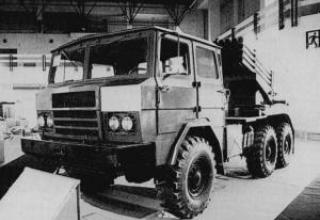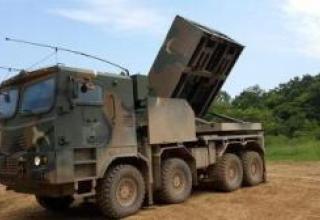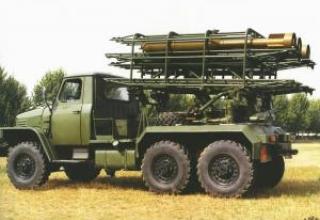The Red Army's successful use of rocket-propelled artillery during the Second World War contributed to the deployment of new research and development activities in this field, both in its final phase and after its completion. In doing so, both combat vehicles and rockets were improved.
During development, the system was designated "M-13A". Its development was based on the tactical and technical requirements №006 for the rocket system "M-13A" by the 4th Directorate of the Main Artillery Directorate of the Armed Forces, approved by the Commander of the Artillery of the Armed Forces, Chief Artillery Marshal Voronov on 25.04.1947.
In 1952, the Soviet Army adopted the BM-14 fighting vehicle (index 8U32) for the launch of 140 mm M-14-OF turbojet shells. In 1955, the MC-14 chemical projectile was adopted for service. In 1958, the M-14D projectile was adopted for laying smoke screens. The designation of the system was M-14.
Later on, BM-14M (2B2), BM-14MM (2B2R), BM-14-17, BM-14-17M and a towed RPU-14 rocket launcher were developed to launch these shells in the USSR. A towed WP-8z rocket launcher was developed in Poland. It is also known about the single-barrel portable launcher used by the special forces.
This system was produced for a long time by the Soviet defense industry and, in addition to the Soviet Army, was in service with the armies of the Warsaw Pact countries, as well as in Algeria, Angola, Cambodia (the tracked version is available), China, Egypt, DPRK, Somalia, Syria, Vietnam and Laos. The system is still in service with the Lao Army (see Photo 1, Photo 2), and can also still be operated in the armies of several countries.
In 1955, specialists of Plant No. 121 (nowadays JSC "Bryansk Red Banner of Labor Chemical Plant named after the 50th Anniversary of the USSR") developed and handed over for export technical documentation, including on the M-14OF product.
Composition:
The BM-14 fighting vehicle is made according to the classical layout: the artillery part is located in the rear of the chassis. It consists of a package of rails, farm, swivel frame, swiveling, lifting and balancing mechanisms, sighting devices, electrical equipment, pedestals, underframe and special chassis equipment. (See BM-14 image gallery).
The guide package consists of sixteen smoothbore tubes, arranged in two rows of eight in each (see photo). Contact levers, front and rear stops are mounted on the tubes (see diagram). Farm (guide package, cradle) - welded construction. It was installed in the bearings of the swing frame brackets and together with the barrels formed the oscillating part of the combat vehicle. The farm consisted of a front and rear cage and cross tubes. The swinging mechanism was worm-type. Screw-type lifting mechanism. Push-type counterbalancing mechanism, designed to reduce the force on the drive handle of the lifting mechanism. The turning frame with the farm established on it, the pointing mechanisms and the balancing mechanism represented a rotating part. The swivel frame was rotated by the swivel mechanism on a pedestal supported by three vertical rollers. Six horizontal rollers centered the rotation of the turning frame and kept it from tipping over. With the help of guidance mechanisms, the guide package can be guided in the vertical plane in the range of angles from 0° to +50°, the horizontal firing angle is 140° (70° to the left and right of the longitudinal axis of the machine).
BM-14 was equipped with a mechanical panoramic sight with a drum, also equipped with a side level.
When the launcher is moved from a camping position to a combat observation glass, the cabs are closed with folding armour panels and the rear part of the chassis is hanged above the ground with the help of two supports with screw jacks. This takes 1.5-2 minutes. The launcher can be fired in single shots, but the main mode of fire is in volleys. The duration of the volley is 7-10 seconds. Shooting is controlled from the cab of the vehicle or by remote control at a distance of up to 60 m from the combat vehicle. The launcher is manually charged for 2-3 minutes. When fully loaded, the launcher is able to perform long marches. The combat calculation of the launcher consists of seven persons. On the march, the commander of the vehicle and the driver are placed in the cab, and the other members of the calculation - on the seats mounted open behind the cab.
Initially, the BM-14 combat vehicle was placed on the modified base of the ZIS-151 three-axle cross-country vehicle, and after the renaming of the Stalin Factory into the Likhachev Factory - ZIL-151. Artillery units of BM-14M (2B2) and BM-14MM (2B2R) combat vehicles were mounted on the modified chassis of ZIL-157 and ZIL-131 trucks respectively. The artillery pieces of the BM-14 (8U32), BM-14M (2B2) and BM-14MM (2B2R) combat vehicles were identical. The swivelling frame was uniform for the above combat vehicles as well as for BM-24 vehicles.
Used to create the BM-14 combat vehicle, the chassis of the ZIS-151 had a six-cylinder carburetor engine ZIS-121 with an output of 92 hp (at 2600 rpm). The transmission used a two-disc dry clutch, five-speed gearbox and two-speed transfer gearbox. Operating range of the transmission was 14. The chassis is made on wheel arrangement 6x6. The front suspension is on two longitudinal semi-elliptic springs with hydraulic shock absorbers of two-sided action, the rear suspension is balancer. Leverage hydraulic shock absorbers and hinges of equal angular speeds such as "Bendix Weiss" are included into the front wheels suspension. The equipment of the car also included hydraulic brakes. The launcher on this chassis has a satisfactory cross-country ability. It has a maximum speed of 60 km/h when driving on the highway.
The chassis of ZIL-131, which housed the BM-14MM, has a carburetor engine with a capacity of 150 hp. Its cross-country ability is significantly increased due to the presence of a centralized system of regulation of air pressure in tires.
The main type of projectile for the BM-14, BM-14M and BM-14MM was the 140-mm unmanned turbojet M-14-OF (see description).
In addition to the M-14-OF fragmentation blowout projectile, the ammunition of the above combat vehicles included M-14D smoke-smoking projectiles (see description).
140 mm turbojet projectiles with a warhead equipped with warfare agents were also designed and produced.
In the explanatory note of the Deputy Chief of the GAU Major-General of Engineering and Technical Service A. V. Bogdanovich. Sokolov dated December 11, 1952 provides data that in addition to the plan of development and research on land-based reactive armament for 1952-1953, which was under consideration in the Council of Ministers of the Union of Soviet Socialist Republics, it was proposed to develop a combat vehicle BM-14 on the basis of a floating tracked armored personnel carrier designed for firing 140 mm fragmentation shells M-14-OF. This work was singled out for inclusion into the 1953 draft plan by the Deputy Minister of War, Lieutenant-General of the Tank Troops, Comrade Vershinin V.G. due to the need of armoured and mechanised forces for powerful and fast tracked reactive systems capable of accompanying armoured and mechanised units.
Characteristics:
| Feature | BМ-14 | BМ-14М | BМ-14ММ |
| Dimensions in camping position, mm: - length with winch - no winch length - width - altitude |
7260 6930 2300 2650 |
7260 6930 2330 2560 |
7260 6930 2500 2750 |
| Height at highest elevation angle, mm | 2970 | 3045 | 3230 |
| Weight, kg: - loaded PM with the calculation - BM without shells and calculation - artillery unit - farms - swivel frame - worm gear pipes - lifting device - balancing mechanism - jack - booster seats - cabin guards |
8200 7000 2120 118 280 200 60 40 33,5 114 71 |
8080 7000 2120 118 280 200 60 40 33,5 114 71 |
9340 7000 2120 118 280 200 60 40 33,5 114 71 |
| Time to move from camping to combat without recharging, mines. | 1.5 | ||
| Time of transfer from combat to camping, mines | 2 | ||
| The time it takes to charge a combat vehicle, mines. | 2 | ||
| Lifting gear drive handle force, kg | up to 10 | ||
| Force on swing drive wheel, kg | up to 8 | ||
| Change of elevation angle in one revolution of the lifting gear drive handle | 0°40' | ||
| Changing the swing angle in one turn of the rotary handwheel | 1°40' | ||
| Maximum speed of a charged PM, km/h. | up to 60 | ||
| Maximum pulling force of the winch, kg | 4500 | ||
| Highest ford depth with hard bottom, overloaded by charged PM, mm | 750 | ||
| The greatest lift over a charged PM in dry and hard ground, hail. | 28 | ||
| Minimum salvo time, sec | 7–10 | ||
| Number of trunks, pcs. | 16 | ||
| Inner barrel diameter, mm | 140,3 | ||
| Barrel length, mm | 1370 | ||
| Weight of the barrel, kg | 24 | ||
| Angle of elevation, hail: - minimum - maximum |
0 +50 |
||
| Angle of horizontal guidance, hail: - At elevation angles from 0° to 50° (in horizontal firing sectors from ±41° to ±70°) - at elevation angles from +10° to +50° |
29 ±70 |
||
Testing:
According to the data of the Inquiry on the state as of 1.1.1950, in accordance with the Resolutions of the Council of Ministers of the USSR No.1175-440ss dated 14.1U.48 and No.5766-2166 dated 27.XII.49, the internal ballistics was tested for the development of the TRS-140 (M-13A) turbojet field projectile. Also there were made experimental firing of about 600 pcs. of projectiles, which showed satisfactory results on heap at temperatures of +15º and +50ºС - Wb/X=1/160-1/180 and WD/X=1/160-1/190.
The test of firing at negative charge temperatures (-40°C) showed a sharp deterioration of heap on the side (W/X=1/80-1/90 at satisfactory heap distances (W/X=1/130÷1/150).
The carried out researches have shown, that such sharp deterioration of heap on the side at negative temperatures is a consequence of the big coefficient of linear expansion of powder (20 times more than steel), that leads to excessively big gap between the chamber wall and powder charge, causing eccentricity of projectile mass on the active part of trajectory. At the time of writing, experimental work was under way to improve the heap on the side at negative charge temperatures.
It was planned to finish these works in February 1950 and in March 1950 to submit a batch of shells for factory testing.
Sources:
- Боевая машина БМ-14 (ИНДЕКС 8У32). Руководство службы. – Воениздат, М.: 1958. – С.3, 139.
- Боевые машины БМ-14, БМ-14М, БМ-14ММ. Руководство службы. Издание второе. Военное издательство Министерства обороны Союза ССР. М.: 1972. – С. 3, 151, 189.
- Боевая машина БМ-14-17 (ИНДЕКС 8У36). Руководство службы. Военное издательство Министерства обороны Союза ССР. М.: 1960. – С. 3, 146-147.
- Боевые машины БМ-14-17 и БМ-14-17М (Индексы 8У36, 8У36М). Руководство службы. Военное издательство Министерства обороны СССР. М.: 1983. – C. 3, 5, 7, 10-11.
- Волосухин В.М. Боевые ракеты СССР. 1941-2003 гг. - Новосибирск. СибАГС, 2004. - С.394.
- До сих пор в строю. [Электронный ресурс]. Дата обновления: 03.03.2019 г.) // https://dambiev.livejournal.com/1522345.html (дата обращения: 05.03.2019 г.)
- Красная звезда. - 15.08.1974 г. - №190(15458). - С. 1.
- ОБ'ЯСНИТЕЛЬНАЯ ЗАПИСКА по опытно-конструкторским и научно-исследовательским работам, выдвигаемым в проект плана по наземному реактивному вооружению на 1953 г. ЗАМЕСТИТЕЛЯ НАЧАЛЬНИКА ГАУ генерал-майора инж.техн.службы А.СОКОЛОВА от 11 декабря 1952 года. Подлинник. 10.12.52 г. // ЦАМО РФ. Ф. 81. Оп. 175255сс. Д. 91. Л. 77,78,78об.
- С П Р А В К А О состоянии на 1.1.1950 г. отработки опытных образцов реактивного вооружения согласно Постановлений Совета Министров СССР № 1175-440сс от 14.1У.48 г. и № 5766-2166 от 27.XII.49 г. // РГАЭ. Ф. 334. Оп. 1. Д. 163. Л. 1,3,4. Завизированный документ. Подписи С.Бодрова нет.
- Сагайдако В.В. Развитие завода в 1946-1960-х гг. // ОЧЕРКИ ИСТОРИИ АРТИЛЛЕРИИ ГОСУДАРСТВА РОССИЙСКОГО. Сухопутная артиллерия (под редакцией Начальника ГРАУ Минобороны России генерал-лейтенанта Н.М.Паршина). Составитель М.А.Первов – М.: Столичная энциклопедия, 2017. – С. 542,543.
- ЦАМО РФ. Ф. 81. Оп. 160821сс. Д. 123. Л. 3-12об.
- ЦАМО РФ. Ф. 81. Оп. 173178сс. Д. 435. Л. 10.
- Шунков В.Н. Энциклопедия Реактивной артиллерии. Минск.: ОАО “ПОЛИГРАФКОМБИНАТ Им. Я.Коласа”. – С.185.
- Jane’s Armour and Artillery 1986-1987. – London: Jane’s Publishing Limited, 1988. – P.766.
- Instrukcja Artylerii. Wьz bojowy BM-14. Album Rysunkьw. Ministerstwo Obrony Narodowej. Wydawnictwo Ministerstwa Obrony Narodowej. – 1958.
- 140-мм реактивная система залпового огня БМ-14-16
- Wyrzutnia rakietowa BM-21
- URL: http://www.zonaeuropa.com/20050211_1.htm
- URL: http://pics.livejournal.com/dennis22b/pic/001xad69
- URL: http://pics.livejournal.com/dennis22b/pic/001xbt5x











